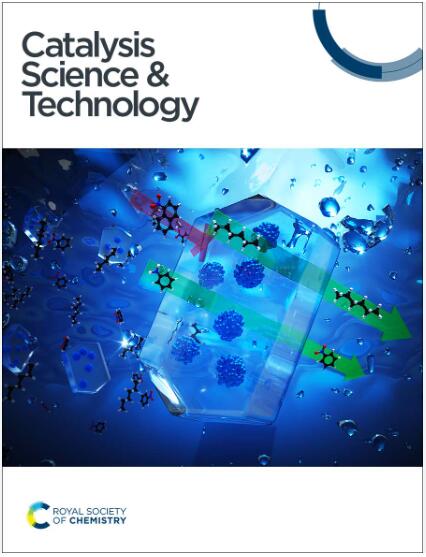二氧化硅负载镍钴合金催化剂上草酸二甲酯加氢制乙醇酸甲酯的研究
IF 4.2
3区 化学
Q2 CHEMISTRY, PHYSICAL
引用次数: 0
摘要
草酸二甲酯(DMO)选择性加氢制乙醇酸甲酯(MG)在聚乙醇酸(PGA)生物降解塑料的工业生产中越来越受到关注。但是,为了实现MG和PGA的大规模生产,仍然需要开发高选择性/活性和价格合理的DMO加氢催化剂。本文研究了二氧化硅负载镍钴合金催化剂对草酸二甲酯选择性加氢制乙醇酸甲酯的催化作用。与单金属Ni或Co相比,在Ni中适当掺杂Co的负载型Ni - Co合金催化剂在温和温度(180℃)下显著提高草酸二甲酯的转化率和乙醇酸甲酯的选择性。在15Ni-10Co /SiO2催化剂上,草酸二甲酯的转化率和乙醇酸甲酯的选择性分别为87%和86%。促进草酸二甲酯转化的原因是H2-TPD吸附氢的容量大、强度强,CO- drifts原位吸附CO和草酸二甲酯(或关键含氧中间体)吸附强度均匀的活性位点。镍和钴的有效相互作用增强了这些现象。此外,还发现酸位的强度对乙醇和甲酸甲酯的产物选择性控制有影响;特别是,酸位和金属位之间的协同作用可能促进草酸二甲酯的深度加氢,形成意想不到的甲酸甲酯。本研究不仅揭示了草酸二甲酯在非贵金属镍钴合金催化剂上加氢的催化行为,而且为设计含多酯基氧化物选择性加氢的镍基催化剂提供了新的思路。本文章由计算机程序翻译,如有差异,请以英文原文为准。

An examination of dimethyl oxalate hydrogenation to methyl glycolate on silica-supported Ni–Co alloy catalysts†
The selective hydrogenation of dimethyl oxalate (DMO) to methyl glycolate (MG) is becoming increasingly attractive for the industrial production of polyglycolic acid (PGA) biodegradable plastics. However, it is still necessary to develop highly selective/active and affordable DMO hydrogenation catalysts for the large-scale production of MG and PGA. In this report, silica-supported Ni–Co alloy catalysts were meticulously investigated for the selective hydrogenation of dimethyl oxalate to methyl glycolate. Compared with monometallic Ni or Co, the supported Ni–Co alloy catalysts with an appropriate doping of Co in Ni resulted in the significant promotion of dimethyl oxalate conversion and methyl glycolate selectivity at mild temperature (180 °C). Optimized dimethyl oxalate conversion and selectivity for methyl glycolate were 87% and 86%, respectively, on the 15Ni–10Co/SiO2 catalyst. The promotion of dimethyl oxalate conversion was attributed to the large capacity and strong strength of hydrogen adsorption, as proven via H2-TPD, and the active sites with uniform strength for CO adsorption and dimethyl oxalate (or key oxygenated intermediates) adsorption, as proven via in situ CO-DRIFTS. These phenomena were enhanced by the effective interaction between Ni and Co. Furthermore, it was found that the strength of acid sites has an influence on product selectivity control for ethanol and methyl formate; particularly, the synergy between the acid sites and metal sites may facilitate deep hydrogenation of dimethyl oxalate to form unexpected methyl formate. This study not only shows the catalytic behavior of dimethyl oxalate hydrogenation on non-precious Ni–Co alloy catalysts but also provides new insights into designing Ni-based catalysts for the selective hydrogenation of oxygenates with multiple ester groups.
求助全文
通过发布文献求助,成功后即可免费获取论文全文。
去求助
来源期刊

Catalysis Science & Technology
CHEMISTRY, PHYSICAL-
CiteScore
8.70
自引率
6.00%
发文量
587
审稿时长
1.5 months
期刊介绍:
A multidisciplinary journal focusing on cutting edge research across all fundamental science and technological aspects of catalysis.
Editor-in-chief: Bert Weckhuysen
Impact factor: 5.0
Time to first decision (peer reviewed only): 31 days
 求助内容:
求助内容: 应助结果提醒方式:
应助结果提醒方式:


